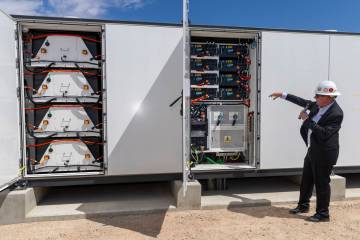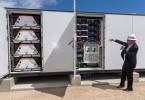Study says green energy mandates kill jobs but Nevada experts disagree
CARSON CITY — A new study on the cost of green energy mandates concludes that states such as Nevada that have imposed requirements to use solar, wind and other energy sources are killing jobs and hurting the economy.
In Nevada, energy prices are expected to climb by nearly 15 percent this year, which will reduce statewide employment growth by more than 11,000 jobs and reduce economic growth by $1.7 billion, said Timothy Considine, a professor with the School of Energy Resources and the Department of Economics and Finance at the University of Wyoming.
But Nevada energy experts have raised questions about the reliability of the study, the Nevada Policy Research Institute, a conservative think tank, published on its website on June 9.
Nevada has a mandate, called Renewable Portfolio Standards, to generate 25 percent of its electricity demand through renewable energy by 2025. This target has been achieved.
Renewable standards not only directly affect utility bills, but “everything from job growth to business investment is also negatively affected by government’s diktat that everyone must turn to less dependable and more expensive energy production,” Considine said in his study, “Evaluating the Costs and Benefits of Renewable Energy Portfolio Standards.”
Considine could not be reached for comment on the questions raised about the report, which does not include a publication date.
Robert Johnston, senior attorney for Western Resource Advocates, an environmental group, notes that the study uses a cost figure of $78 a megawatt hour from large solar projects in Nevada.
But the four most recent solar “purchased power” agreements with NV Energy have a cost of less than $50 a megawatt hour, with three of the four having a first-year price of less than $40 a megawatt hour, he said.
In a purchased power agreement, an energy project developer builds a power plant for a utility in exchange for the delivery of electricity at a certain rate over a set time.
The report also assumes that large solar projects will operate on a limited basis of about 23 percent of the 8,760 available hours each year. But Johnston said the new solar projects use single-axis tracking to follow the sun’s path and thus will have capacity at around 31 percent, greater than the figure used in the study.
There is also the question of the nearly 15 percent increase in energy costs projected in the study for the current year.
RATES DECLINING
Nevada Power reports that there have been three rate decreases for customers starting July 1, 2015, because of lower energy costs. As of April 1, a typical single family residential customer bill had dropped $18.26, or 11.8 percent from June 30, 2015.
Rates are dropping again July 1.
Nevada Power customers also have slightly lower average bills today than in summer 2007. In July 2007, the average bill for a single-family residential customer was $137.72. Today, it is $136.29. Both bill calculations are based on today’s average energy consumption of 1,141 kilowatts per month.
The Levelized Cost of Energy Analysis, a widely used report from Lazard, an investment bank, compares the costs of different types of energy production.
The analysis, which was updated in November 2015, shows, for example, a cost range of $46 to $70 a megawatt hour for large-scale solar, $52 to $78 for natural gas of and $$65 to $150 for coal.
Besides Nevada’s 25 percent green energy standard, the state Legislature in 2013 approved legislation ending Nevada Power’s reliance on coal-powered electricity by 2019. Three of four units at the Reid Gardner coal plant near Moapa were closed in December 2014. The final unit will close next year.
Nevada Power will also end its ownership interest in the Navajo Generating Station near Page, Arizona, by 2019. In all, 812 megawatts of coal-fired generation are being retired or eliminated under the plan. The utility will no longer generate electricity from coal. Natural gas-powered generation is replacing some of this capacity, while wind, geothermal and solar is also in the mix for NV Energy. NV Energy, in response to the study, said the utility remains focused on creating a less-carbon-intense energy supply for customers and is exceeding the renewable portfolio standard without raising customer prices.
“Today, our customers are benefiting from the lowest-cost large-scale solar contracts we’ve ever experienced of less than 4 cents a kilowatt-hour, putting it on par with more traditional forms of generation,” the response said. “NV Energy will continue to work with all stakeholders to advance renewable resources in a cost-effective manner for the benefit of all our customers.”
CONCLUSIONS QUESTIONED
Rose McKinney-James, who consults on energy policy as the managing principal of Las Vegas-based Energy Works Consulting, said Considine’s report appears to have inaccuracies, and he does not appear to fully understand Nevada law as it relates to the state’s renewable portfolio standard.
“I have to say the study raises more questions than it answers,” she said. “From what I’ve read, the author has had a lot of questions raised about his prior work so it raises questions about the veracity of this study.”
Although the fossil fuel industry will lose jobs as investment in renewable energy becomes more widespread, the effect is actually an economic development shift with job creation in the new industries, McKinney-James said.
SB 123 passed in 2013 partly to reduce dependence on imported resources when Nevada has its own supportable and exportable resources in sun, wind and geothermal, she said.
Chandler Sherman, a spokesman for Bring Back Solar Alliance, said recent studies have shown that rooftop solar decreases costs to NV Energy, saving all customers money. A peer-reviewed study by SolarCity and the Natural Resources Defense Council, released in May, found rooftop solar saves Nevadans $7 million every year, whether or not they have rooftop solar.
“The facts are clear: clean energy has been a bright spot in Nevada’s economy, driving exponential job growth and attracting millions of dollars in investment to the state,” she said. “Nevada has one of the best solar resources in the country, and before the solar rate hike, Nevada was the top state in the country for solar jobs.”
SolarCity said it cut 550 jobs when the new rates took effect. A report released in February by the national group the Solar Foundation found that Nevada had the third-largest number of solar jobs among all states in 2015 and the most solar jobs per capita.
That number is expected to decrease dramatically when the 2016 report is published.
“We need strong policies in place so that Nevadans can harness our homegrown solar resources and restore Nevada’s place as a national leader in the clean energy economy,” Sherman said.
The Nevada Office of Energy said NV Energy’s filings with the Public Utilities Commission do not suggest rising energy rates. The utility is expecting its fifth straight rate decrease this year, said Angela Dykema, director of the Nevada Governor’s Office of Energy.
“In addition, the price of utility-scale renewables continues to fall, with Nevada home to two of the lowest cost solar projects in the nation,” she said.
Dykema said that since 2009, Nevada’s Renewable Energy Tax Abatement Program has led to the construction of almost 30 renewable power plants, which have led to the creation of more than 4,000 high-paying jobs.
Also, she said, the state received more than $6.5 billion in economic benefits resulting from capital investments, payroll, and taxes paid from these renewable resources.
Contact Sean Whaley at swhaley@reviewjournal.com or 775-461-3820. Follow @seanw801 on Twitter.
RELATED
Leaders agree task force is best way to move Nevada ahead on green energy
Net metering rules may change Nevada's green energy strategy





























